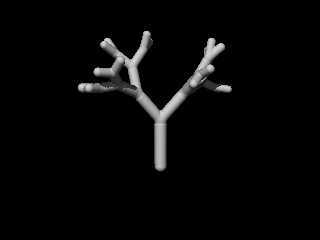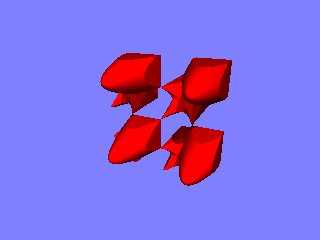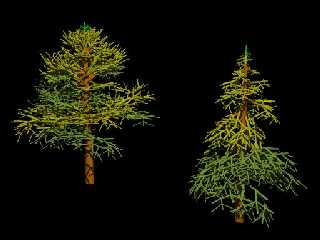 |
 |
|
 |
|
 |
|  |
|  |
|
 |
|
 |
|  |
|  |
|
 |
Bill DeWitt wrote:
>
> I like to think that -anything- can be done with isosurface if one can
> figure out the formula. I cannot figure out anything but the basics, and
> some random thrashing around with those. But I am still struggling with an
> isosurface tree. So far I haven't even been able to reach my first goal, a
> "Y"...
:-)
I just wrote some thoughts i had, maybe i will try it out myself sometime, it
should really be more simple than a realistic tree ...
Christoph
--
Christoph Hormann <chr### [at] gmx de>
Homepage: http://www.schunter.etc.tu-bs.de/~chris/ de>
Homepage: http://www.schunter.etc.tu-bs.de/~chris/
Post a reply to this message
|
 |
|  |
|  |
|
 |
From: Greg M Johnson
Subject: Re: Isosurface (was Re: Basket-weaving (fun with spline objects))
Date: 24 Oct 2000 10:09:49
Message: <39f5982d@news.povray.org>
|
|
 |
|  |
|  |
|
 |
Bill DeWitt wrote:
> But I am still struggling with an
> isosurface tree.
Post a reply to this message
|
 |
|  |
|  |
|
 |
From: Bill DeWitt
Subject: Re: Isosurface (was Re: Basket-weaving (fun with spline objects))
Date: 24 Oct 2000 12:31:03
Message: <39f5b947$1@news.povray.org>
|
|
 |
|  |
|  |
|
 |
"Greg M. Johnson" <"gregj;-()"@aol.c;-()om> wrote in message
news:39f5982d@news.povray.org...
>
>
> Bill DeWitt wrote:
>
> > But I am still struggling with an
> > isosurface tree.
>
> Did you see my example at p.b.i.:
Yes I did, but I was thinking of working from the trunk out, yours seems
to model the outer leaves only.... or do I misunderstand it?
I want to make a branching shape that I can then put leaves on. I
suspect that it can be done, but I haven't been able to get anywhere with it
at all.
Post a reply to this message
|
 |
|  |
|  |
|
 |
|
 |
|  |
|  |
|
 |
In article <39f5b947$1@news.povray.org>, "Bill DeWitt"
<the### [at] earthlink net> wrote:
> I want to make a branching shape that I can then put leaves on. I
> suspect that it can be done, but I haven't been able to get anywhere
> with it at all.
I whipped up this isosurface tree in about 20 minutes...but I cheated.
:-)
I made a fractal blob, then used the blob pattern in a pigment in a
pigment function, and called that function from the isosurface. Not too
slow...and it still has many of the benefits of isosurfaces.
I don't think you are going to get a realistic looking, complex plant
out of an ordinary function...it would certainly be possible, but the
function would probably be horribly complex, inflexible, and slow
rendering. Maybe if you designed some new pattern and used that in the
isosurface...
You can get some odd branch-like structures that look fairly natural
from a distance pretty easily, just by displacing a sphere with a
pigment. Not exactly a tree though...
--
Christopher James Huff
Personal: chr### [at] mac net> wrote:
> I want to make a branching shape that I can then put leaves on. I
> suspect that it can be done, but I haven't been able to get anywhere
> with it at all.
I whipped up this isosurface tree in about 20 minutes...but I cheated.
:-)
I made a fractal blob, then used the blob pattern in a pigment in a
pigment function, and called that function from the isosurface. Not too
slow...and it still has many of the benefits of isosurfaces.
I don't think you are going to get a realistic looking, complex plant
out of an ordinary function...it would certainly be possible, but the
function would probably be horribly complex, inflexible, and slow
rendering. Maybe if you designed some new pattern and used that in the
isosurface...
You can get some odd branch-like structures that look fairly natural
from a distance pretty easily, just by displacing a sphere with a
pigment. Not exactly a tree though...
--
Christopher James Huff
Personal: chr### [at] mac com, http://homepage.mac.com/chrishuff/
TAG: chr### [at] tag com, http://homepage.mac.com/chrishuff/
TAG: chr### [at] tag povray povray org, http://tag.povray.org/
<>< org, http://tag.povray.org/
<><
Post a reply to this message
Attachments:
Download 'isotree.jpg' (4 KB)
Preview of image 'isotree.jpg'

|
 |
|  |
|  |
|
 |
|
 |
|  |
|  |
|
 |
"Chris Huff" <chr### [at] mac com> wrote :
>
> I whipped up this isosurface tree in about 20 minutes...but I cheated.
> :-)
Sure did! Cheaters never prosper....
> I don't think you are going to get a realistic looking, complex plant
> out of an ordinary function...
Don't say things like that!
I don't really think I will get it no matter if it is possible or not.
Below is how far I got today. And as I said, all I am trying for is a simple
"Y". com> wrote :
>
> I whipped up this isosurface tree in about 20 minutes...but I cheated.
> :-)
Sure did! Cheaters never prosper....
> I don't think you are going to get a realistic looking, complex plant
> out of an ordinary function...
Don't say things like that!
I don't really think I will get it no matter if it is possible or not.
Below is how far I got today. And as I said, all I am trying for is a simple
"Y".
Post a reply to this message
Attachments:
Download 'Isotree0012.jpg' (7 KB)
Preview of image 'Isotree0012.jpg'

|
 |
|  |
|  |
|
 |
|
 |
|  |
|  |
|
 |
In article <39f62a60@news.povray.org>, "Bill DeWitt"
<the### [at] earthlink net> wrote:
> Below is how far I got today. And as I said, all I am trying for is a
> simple "Y".
Just a "Y"? That's easy...
function {if(-y, R1(x,y,z), R1(-abs(x)+y,y,z))-1}
Getting the branches to branch is what would make the function so
complex, and getting random variations in branch numbers, size, length,
etc. will be even more difficult. And the result probably won't render
in a reasonable speed.
--
Christopher James Huff
Personal: chr### [at] mac net> wrote:
> Below is how far I got today. And as I said, all I am trying for is a
> simple "Y".
Just a "Y"? That's easy...
function {if(-y, R1(x,y,z), R1(-abs(x)+y,y,z))-1}
Getting the branches to branch is what would make the function so
complex, and getting random variations in branch numbers, size, length,
etc. will be even more difficult. And the result probably won't render
in a reasonable speed.
--
Christopher James Huff
Personal: chr### [at] mac com, http://homepage.mac.com/chrishuff/
TAG: chr### [at] tag com, http://homepage.mac.com/chrishuff/
TAG: chr### [at] tag povray povray org, http://tag.povray.org/
<>< org, http://tag.povray.org/
<><
Post a reply to this message
|
 |
|  |
|  |
|
 |
|
 |
|  |
|  |
|
 |
Post a reply to this message
|
 |
|  |
|  |
|
 |
|
 |
|  |
|  |
|
 |
Bill DeWitt wrote:
>
> > And the result probably won't render
> > in a reasonable speed.
>
> Well see that is what I was hoping you wouldn't say. There are
> various -great- tree macros to be had, but I was assuming that an isosurface
> would be quicker.
Concerning efficiency, both a macro tree and a (hypothetical) isosurface have
advantages, the macro tree would probably render faster as a single object
(assuming both are equally complicated), but when placing a lot of trees in one
scene, the isosurface has strong advantages because of fewer memory use.
Christoph
--
Christoph Hormann <chr### [at] gmx de>
Homepage: http://www.schunter.etc.tu-bs.de/~chris/ de>
Homepage: http://www.schunter.etc.tu-bs.de/~chris/
Post a reply to this message
|
 |
|  |
|  |
|
 |
|
 |
|  |
|  |
|
 |
Christoph Hormann wrote:
> Concerning efficiency, both a macro tree and a (hypothetical) isosurface have
> advantages, the macro tree would probably render faster as a single object
> (assuming both are equally complicated), but when placing a lot of trees in one
> scene, the isosurface has strong advantages because of fewer memory use.
LSystmes were designed for this purpose but have a bit of a learning
curve involved. Too bad there are no really good LSystem modelling
programs available.
--
Ken Tyler - 1400+ POV-Ray, Graphics, 3D Rendering, and Raytracing Links:
http://home.pacbell.net/tylereng/index.html http://www.povray.org/links/
Post a reply to this message
|
 |
|  |
|  |
|
 |
|
 |
|  |
|  |
|
 |
Ken wrote:
>
> LSystmes were designed for this purpose but have a bit of a learning
> curve involved. Too bad there are no really good LSystem modelling
> programs available.
>
L-Systems have the same disadvantages as tree macros (IIRC most tree macros are
essentially specialized l-systems with some improvements).
BTW, a l-system modelling program would be quite difficult, because l-systems
are coded in fact and therefore can't be modelled, you could only try to
generate the l-system definition from some modelled shape, but that would not be
of much use IMO.
Attached are two coniferous trees i made with l-systems some years ago.
Christoph
--
Christoph Hormann <chr### [at] gmx de>
Homepage: http://www.schunter.etc.tu-bs.de/~chris/ de>
Homepage: http://www.schunter.etc.tu-bs.de/~chris/
Post a reply to this message
Attachments:
Download 'lsys_01.jpg' (38 KB)
Preview of image 'lsys_01.jpg'

|
 |
|  |
|  |
|
 |
|
 |
|  |




![]()